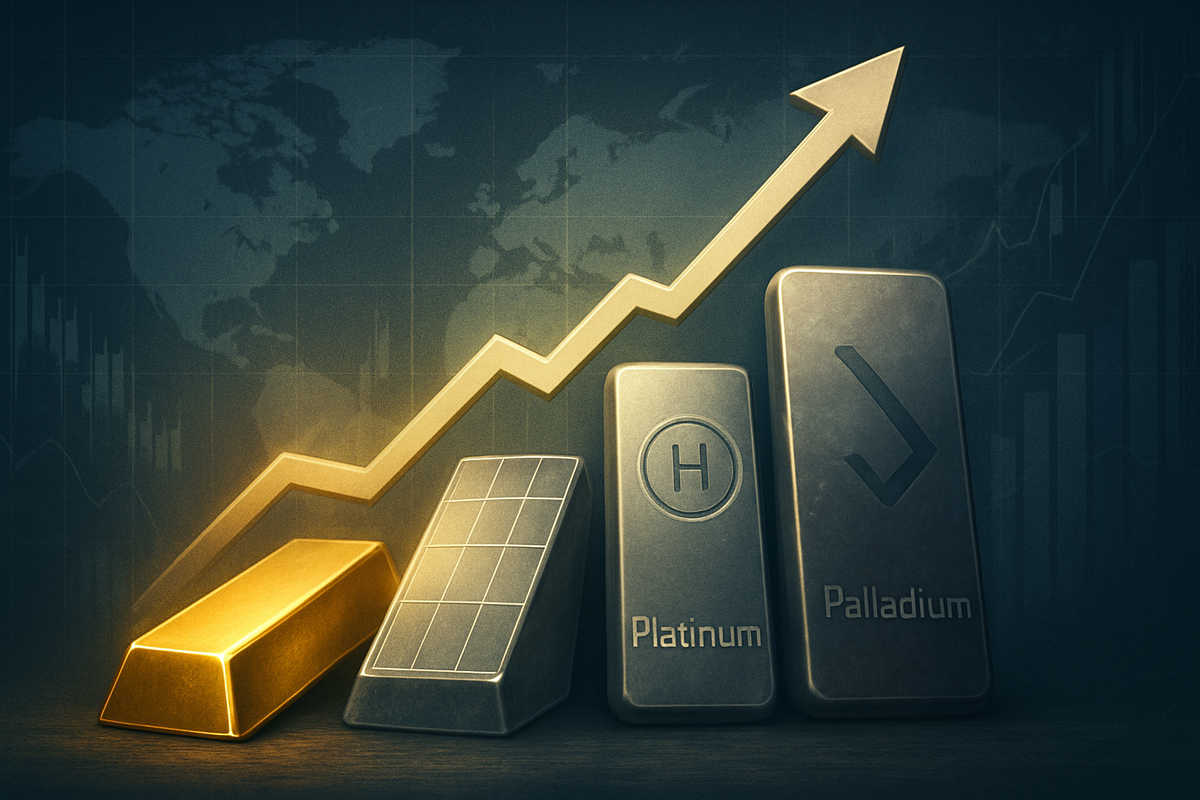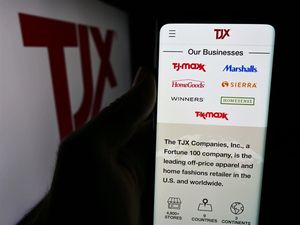
The precious metals market presented a complex and dynamic landscape on Thursday, November 13, 2025, as investors weighed global economic uncertainties against the prospect of shifting monetary policies. While gold and silver generally extended their upward trajectory, buoyed by safe-haven demand and expectations of Federal Reserve rate cuts, platinum and palladium experienced more mixed signals, with some reports indicating downward pressure despite underlying long-term bullish fundamentals. The interplay of inflation concerns, geopolitical tensions, and industrial demand drivers created a nuanced environment for these valuable commodities, setting the stage for continued volatility and strategic repositioning.
Detailed Market Movements on November 13, 2025
Thursday, November 13, 2025, saw a mixed but generally robust performance across the precious metals spectrum, reflecting the diverse forces at play in global markets.
Gold (Au) continued its ascent, with international spot prices strengthening by 2.45% to reach $4,210.98 per ounce. This upward momentum was largely attributed to renewed investor interest in safe-haven assets amidst persistent global economic uncertainty and a weakening U.S. dollar, which made dollar-denominated commodities more attractive. Expectations of further Federal Reserve interest rate cuts in December also boosted the appeal of non-yielding assets like gold. Geopolitical risks, particularly ongoing tensions in the Middle East, and persistent inflationary pressures further underpinned gold's role as a hedge against the erosion of purchasing power. Technical analysis indicated a bullish bias, with stability above the psychological $4,200 area and potential for prices to retest $4,200 if yields remained soft, with some analysts forecasting a break above $4,400-$4,500/oz before year-end.
Silver (Ag) largely tracked gold's positive momentum, recording notable gains. Silver futures were up by 0.32% to $53.10, and spot prices climbed to $54.39 per ounce, nearing its record high of $54.48 from October 17, 2025. This surge was fueled by similar safe-haven flows as gold, coupled with robust and sustained industrial demand. The clean energy sector, particularly solar panel manufacturing and electronics, continues to be a significant driver for silver. Eased U.S. yields and a softer dollar also contributed to renewed appetite for the metal. Despite some conflicting reports of a falling trend on the day, the overall sentiment remained constructive, reinforced by technical indicators signaling strong upward momentum and a bullish breakout from an inverse head and shoulders pattern on MCX Silver. The market deficit, now in its fifth consecutive year for silver in 2025, provided further underlying strength.
Platinum (Pt), however, presented a more challenging picture on November 13, generally showing a falling trend. Prices lost 1.87% from $1582.50 per troy ounce, trading in a daily range of $1576.88 to $1631.57. Platinum futures were down by 1.89% to $1613.30. This decline came despite earlier analysis indicating a rally above the $1605.00 level, hitting $1625.00, which had signaled a potential resumption of a bullish attack. Key drivers for platinum include ongoing supply shortages from weak mining output and recovering demand from both the jewelry and industrial sectors. The automotive sector's increasing trend towards reducing palladium in favor of platinum in catalytic converters, driven by stricter environmental regulations, is also a significant long-term factor. Despite the day's dip, industry analysts often consider platinum historically undervalued, presenting long-term investment opportunities.
Palladium (Pd) also experienced downward pressure on November 13, losing 2.19% from $1435.00 per troy ounce, with a daily range of $1429.73 to $1492.46. While some reports noted it was largely unchanged, the general trend for the day was negative. Palladium had previously hovered around $1,390-$1,400 an ounce, retreating from a mid-October peak of $1,655. The metal's price movements were influenced by a broader precious metals rally earlier in the year, fueled by inflation concerns. However, softening expectations for further Federal Reserve rate cuts and an easing of safe-haven demand following a US-China trade agreement contributed to its retreat. Weaker physical demand and a less friendly macroeconomic backdrop were also cited as contributing factors. Despite the short-term declines, analysts forecast palladium to trade at 1600.31 USD/t oz in 12 months, indicating a generally positive longer-term outlook.
Corporate Fortunes: Winners and Losers in the Precious Metals Market
The fluctuating prices of precious metals on November 13, 2025, and the broader trends of the year, have significant implications for public companies operating in mining, refining, and trading.
Gold and Silver Miners like Newmont (NYSE: NEM), the world's largest gold miner, and Barrick Gold (NYSE: ABX), the second-largest, would have seen a positive sentiment boost from gold's 2.45% rise. Higher gold prices directly translate to increased revenues and improved profit margins for these companies, assuming stable production costs. For Newmont, a sustained increase in gold prices can mean tens of millions in additional revenue, impacting quarterly results. Similarly, silver-focused producers such as Pan American Silver (NASDAQ: PAAS) and First Majestic Silver (NYSE: AG) would benefit substantially from silver's rally, enhancing their profitability and potentially encouraging expanded exploration and production efforts. These companies might also use increased cash flows to reduce debt, increase dividends, or initiate share buybacks.
Precious Metals Streaming Companies, such as Wheaton Precious Metals (NYSE: WPM), are particularly sensitive to rising metal prices. Their business model involves acquiring future production at a fixed, lower price, meaning higher spot prices directly widen their profit margins on each ounce streamed. The strong performance of gold and silver on November 13, 2025, would have been highly positive for WPM's stock, reflecting increased anticipated cash flow and potentially leading to more opportunities for new streaming agreements with miners.
Platinum and Palladium Miners, including Anglo American Platinum (OTCPK: ANGPY), Impala Platinum Holdings (OTCQX: IMPUY), and Sibanye-Stillwater (NYSE: SBSW), faced headwinds from the daily price declines in platinum and palladium. A nearly 2% drop in prices for these metals in a single day could trigger investor apprehension and put downward pressure on their stock values. While these companies have generally seen positive trends for PGMs earlier in 2025, daily fluctuations can still impact short-term profitability. Sibanye-Stillwater, being diversified into gold, might have seen some buffering from gold's positive movement. Despite the short-term dips, the overall bullish trend for PGMs throughout 2025 encourages these companies to maintain or increase production and invest in cost efficiencies to capitalize on higher average prices.
Refining and Trading Companies like Johnson Matthey (LSE: JMAT) and Glencore International AG (LSE: GLEN) experience a more mixed impact. Stable and high precious metal prices generally lead to increased material flow and demand for their services. However, a diversified company like Glencore would see a mixed effect from the day's movements – positive from gold and silver, negative from platinum and palladium. Johnson Matthey, with its significant focus on PGMs for automotive catalysts, would be sensitive to palladium and platinum prices, meaning the downward movement on November 13, 2025, could have created minor headwinds. These companies focus on optimizing refining capacity, managing inventory risks, and expanding recycling services.
Broader Significance and Historical Context
The market movements on November 13, 2025, for precious metals fit into a broader narrative of global economic and geopolitical shifts, reinforcing their traditional roles while highlighting emerging trends.
The sustained demand for gold and silver underscores their enduring status as critical safe-haven assets during periods of global instability and economic uncertainty. The ongoing conflicts in Ukraine and the Middle East, coupled with persistent inflation and central bank diversification away from the U.S. dollar, have fueled this safe-haven buying, echoing historical rallies seen in the 1970s and 1980s during times of currency debasement and geopolitical stress. The consistent net buying of gold by central banks, especially in emerging markets, represents one of the strongest streaks in modern history, signaling a long-term strategy to diversify national reserves.
For silver, its outperformance of gold in 2025 (74% YTD gain vs. gold's 55%) highlights its increasing link to the green energy transition. The booming clean energy sector, particularly solar panel manufacturing, is creating robust and structural industrial demand. This trend positions silver as a critical commodity in the global decarbonization effort, distinct from its traditional safe-haven role, and draws comparisons to past periods where industrial applications significantly drove its price.
Platinum and palladium are navigating a more complex landscape. While palladium has historically been driven by automotive catalytic converters, the accelerating shift towards electric vehicles (EVs) poses a long-term challenge, as EVs do not use these components. This structural headwind is encouraging the substitution of palladium with platinum in catalytic converters, and platinum is also gaining prominence in the burgeoning hydrogen economy, particularly in fuel cell electric vehicles (FCEVs) and green hydrogen production. This represents a significant industry trend where one PGM is potentially displacing another, driven by technological evolution and environmental regulations.
Regulatory and policy implications are also at play. Central bank interest rate decisions, particularly expectations of cuts, remain key drivers. The London Metal Exchange's (LME) decision to withdraw from administering platinum and palladium auctions by mid-2026 signals broader industry trends towards operational specialization and regulatory compliance, requiring market participants to prepare for new benchmark administrators. Furthermore, controversial trade plans and tariffs can contribute to inflation and economic uncertainty, indirectly driving demand for precious metals.
Historically, the current market structure, with increased accessibility through Exchange Traded Funds (ETFs), allows for broader retail investor participation, which can amplify price movements compared to past gold bull markets like those in 1980 or 2011, which were primarily driven by institutional and professional investors.
What Comes Next: Navigating Future Horizons
The precious metals market is poised for continued dynamism, with both short-term volatility and significant long-term structural shifts on the horizon.
In the short term, gold's performance will remain highly sensitive to immediate macroeconomic data, such as inflation reports and jobs figures, as well as central bank rhetoric regarding interest rates. A more dovish pivot from the Federal Reserve or an escalation of global conflicts could provide immediate upward momentum, while stronger-than-expected economic data might temper its appeal. Silver will likely mirror gold's movements but with higher volatility, also reacting to global manufacturing health due to its industrial demand. Platinum and palladium will continue to be influenced by the automotive sector's production rates and any immediate shifts in supply from key mining regions.
Looking at the long term, the outlook for gold appears robust. Persistent geopolitical risks, structural inflationary pressures from decarbonization and deglobalization, and ongoing sovereign debt concerns are expected to maintain gold's appeal as a store of value. Central bank buying is anticipated to continue, providing a fundamental demand floor. Experts foresee gold prices trending upward, potentially reaching between $2,500 and $3,000 per ounce, with some aggressive projections reaching $4,500-$5,000 per ounce by late 2026.
Silver's long-term prospects are increasingly tied to the global energy transition. Its critical role in solar panels, 5G technology, and electric vehicles suggests a strong demand trajectory. Supply constraints from mining are expected to continue, supporting higher prices, with forecasts suggesting silver could reach $40 per ounce by Q3 2025 and potentially $60-$100 per ounce by 2030.
Platinum faces a period of transformation. While demand from internal combustion engine (ICE) vehicles may decline, its role in hydrogen fuel cell technology and the broader hydrogen economy is a significant future growth driver. The market is projected to remain in a supply deficit through 2025-2029, supporting prices and offering long-term growth potential if hydrogen technologies gain widespread adoption.
Palladium, however, faces significant structural headwinds. The accelerating shift towards electric vehicles, which do not use catalytic converters, will likely reduce demand. Substitution with platinum in catalytic converters is also an ongoing trend. While minor demand exists in electronics and dentistry, it's unlikely to fully offset automotive declines. Palladium is expected to experience continued price volatility with a long-term structural decline as the automotive industry shifts away from ICE vehicles, potentially falling below $600-$900 per ounce over the long term.
Strategic pivots for market participants will involve increased portfolio diversification, potentially favoring platinum and silver due to their roles in the green economy. A keen focus on industrial demand trends for silver and platinum, macroeconomic vigilance for gold, and careful supply chain analysis for PGMs will be crucial. Miners may need to adapt by diversifying their operations or investing in process efficiencies, while investors will need to consider the evolving risk profiles of each metal.
Comprehensive Wrap-Up and Investor Outlook
The precious metals market, as illuminated by Thursday, November 13, 2025, movements and the broader trends of the year, presents a dynamic and multi-faceted landscape for investors and industry stakeholders.
Key Takeaways: Gold and silver are firmly established as safe-haven assets and beneficiaries of the green energy transition, respectively, exhibiting strong upward momentum. Platinum is undergoing a significant transition, poised to benefit from the emerging hydrogen economy, while palladium faces structural challenges due to the automotive industry's shift away from internal combustion engines. Macroeconomic factors like inflation, interest rates, and geopolitical stability remain paramount drivers across the board.
Assessment of the Market Moving Forward: The market will likely continue to be characterized by volatility, driven by the interplay of monetary policy expectations, global economic health, and geopolitical events. Gold and silver are expected to maintain their bullish long-term trajectories, albeit with short-term fluctuations. Platinum holds significant long-term potential tied to the hydrogen economy, but its path will involve adapting to evolving industrial demand. Palladium, conversely, faces a period of structural decline, necessitating careful risk management for those with exposure.
Final Thoughts on Significance and Lasting Impact: The events of 2025, culminating in the trends observed on November 13, underscore the enduring relevance of precious metals in a turbulent world. Their roles as inflation hedges and safe havens are reinforced, while the increasing industrial demand for silver and platinum highlights their critical importance in the global energy transition. This period marks a significant re-evaluation of the long-term prospects for each metal, driven by both traditional market forces and technological advancements.
What Investors Should Watch For: Investors should closely monitor central bank policy decisions, particularly from the Federal Reserve, regarding interest rates. Geopolitical developments, especially in the Middle East and Eastern Europe, will continue to influence safe-haven demand. For silver and platinum, tracking investments and advancements in green energy technologies (solar, hydrogen fuel cells) will be crucial. Palladium investors should pay close attention to the pace of EV adoption and any further shifts in automotive catalytic converter technology. Diversification across precious metals, rather than concentration in a single one, may prove to be a prudent strategy in the months ahead.
This content is intended for informational purposes only and is not financial advice





